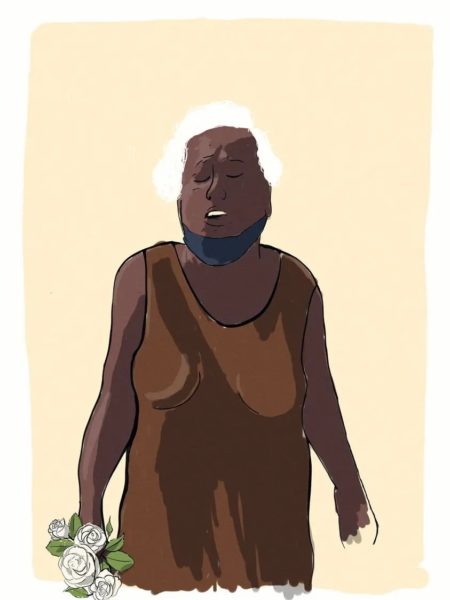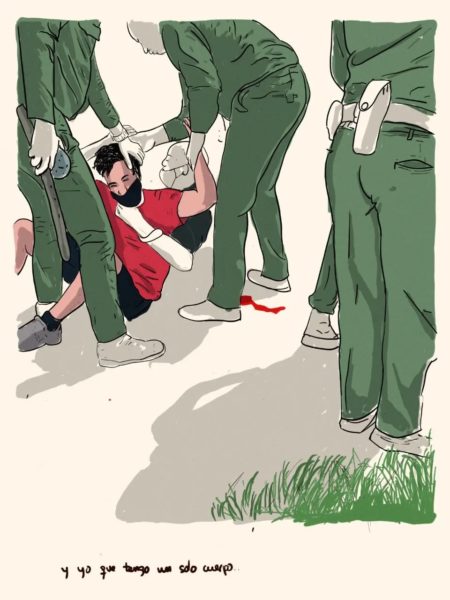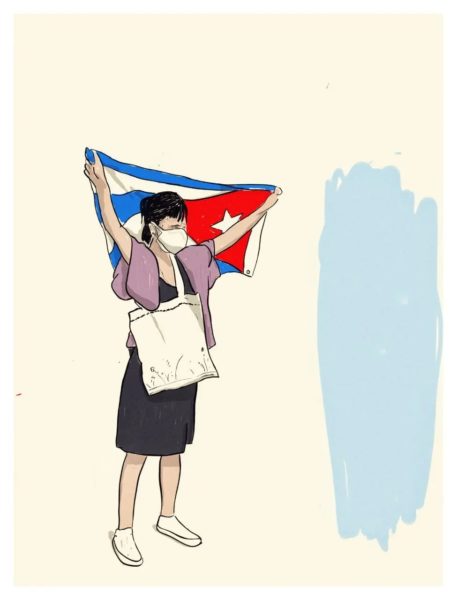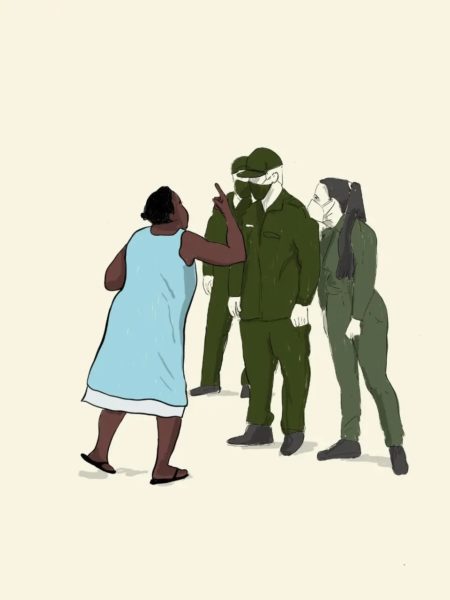Cuba’s “Confused” Faces

By Rachel Pereda* (El Toque)
Illustrations: Ronald Vill
HAVANA TIMES – Eighty-eight-year-old Sara Naranjo took to the streets on July 11th, with a pot in hand. Hitting the old metal pot with the handle of a knife, her photo went viral. This almost blind old woman is one of the many faces of Sunday’s protests.
Photographs soon became drawings. This one and other pictures of the protests. Drawn by Ronald Vill’s hand.
Ronald filters out and synthesizes protagonists and scenes from the abundance of photos and videos taken on July 11th; he iconizes them. “Every drawing is not only a representation of events that day, but also a representation of what we felt that day,” the 30-year-old artist says.
“I choose the most symbolic ones, the ones that represent many things at the same time. In fact, I try to draw on the phone wherever I am, so I make a drawing every day. I just want to express what many of us are feeling,” he points out.
From a photo to a digital drawing
“I live in Playa, but I was born in Mantilla [two different parts of Havana]. I was a freelancer before I became an artist. I was at the Onelio Jorge Cardoso literary training center, but I was horrible as a writer and I started out in the world of photography and film production,” he says.
“Digital drawings have been a tool for me to study images, their composition and light.”

When lockdown began because of COVID-19, Ronald began to draw and would post a drawing on Facebook every day. “They were very simple drawings. I tried to express our everyday, without great artistic ambitions. That’s when I discovered the kind of drawing I was interested in.”
Ronald uses images he downloads from the Internet, or photos he takes himself. Then, he makes a montage on Photoshop and that’s where he begins to draw, trying not to saturate the image, keeping its original framing and “trying to make the emotion of the picture the protagonist.”
The July 11th Protests

Ronald was one of the many young people who took part in the protests on Sunday July 11th. When he learned what was happening in San Antonio de los Baños, he left the house and headed to Central Havana with his girlfriend.
They walked from Coppelia. When they got to Galiano street, they ran into a group of people.
“What I saw then, at that exact moment, wasn’t a protest, it wasn’t even a big gathering. People were running and the police were chasing after them, before the beatings. When you think of a protest, you think that they’ll grab you, push you, arrest you; but what I saw that day was excessive,” he says, still shocked.

“We saw residents on Galiano street calling out to the protestors, telling them to hide in their houses so that the police wouldn’t beat them. I got really scared,” he admits.
“It all seemed like a movie to me. We left running because the crowd headed our way. We saw police officers dressed as civilians. They grabbed pretty much anyone by the neck; they didn’t distinguish between those who were protesting or those who were walking in the street.”
However, Ronald held onto the hope that this wasn’t happening all over the country. When he got to Prado avenue to see if he could find anyone he knew, he had another surprise. “Revolutionaries” were there shouting out slogans.
“Somebody from that crowd gave thanks (shouting) for the opportunity they were given to defend the Revolution and he beat his chest,” he recalls.

After three hours of walking, he decided to go to some friends’ house. “I thought that what I’d seen had been isolated events. Up until then, I was overcome with excitement because we had seen a people take to the streets and protest; people had gone outside to demand what they felt like,” he said.
Reality hit him hard the next day, and this excitement turned into anger, sadness and pain, he says. Havana was full of police. “We didn’t know what had happened because we couldn’t connect to the Internet. My phone didn’t even receive calls or SMS messages. Everything was fine until we began to talk to our friends and receive calls and saw what had really happened.”
As an artist, Ronald felt like it was his place to take part in what was happening around him.

“I decided to draw because it’s a more direct and easier way to reach people, and it works really well on social media when you want to transmit a message,” he says.
The first drawing he did was of a woman, in a robe and with her index finger raised, who was telling off police officers for what was happening. “When I saw that video, I was taken aback. That woman was complaining in the authorities’ face, in the middle of Camaguey square, with an attitude that moved me,” Ronald says.

Drawing these scenes is his way of taking a stand. “I try to use the resources at my disposal to reach people with my drawings, Facebook posts, voice, and I try and demand justice.”
Ronald doesn’t have great artistic ambitions with his drawings, nor does he dream of holding an exhibition; in fact, much of his work don’t have the resolution needed to be printed. “They don’t even have my signature; I keep them as clean as possible so that anyone can use them in their posts or wherever they want to. I think this is the best thing I can do right now: take real stories and transform them into art so that they reach everyone.”
In the meantime, the 30-year-old artist’s drawings capture a moment and immortalize what is happening nowadays on Cuban streets.
—–
*Journalist and mother, or at least I try. Hardcore Sabina fan. Lover of literature, impossible causes, photography, coffee, and adventure. Gemini and dreamer. I believe in magic and the history behind a story. I am still waiting for my letter from Hogwarts.





